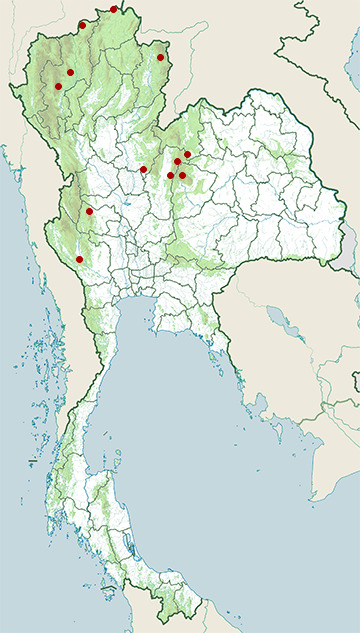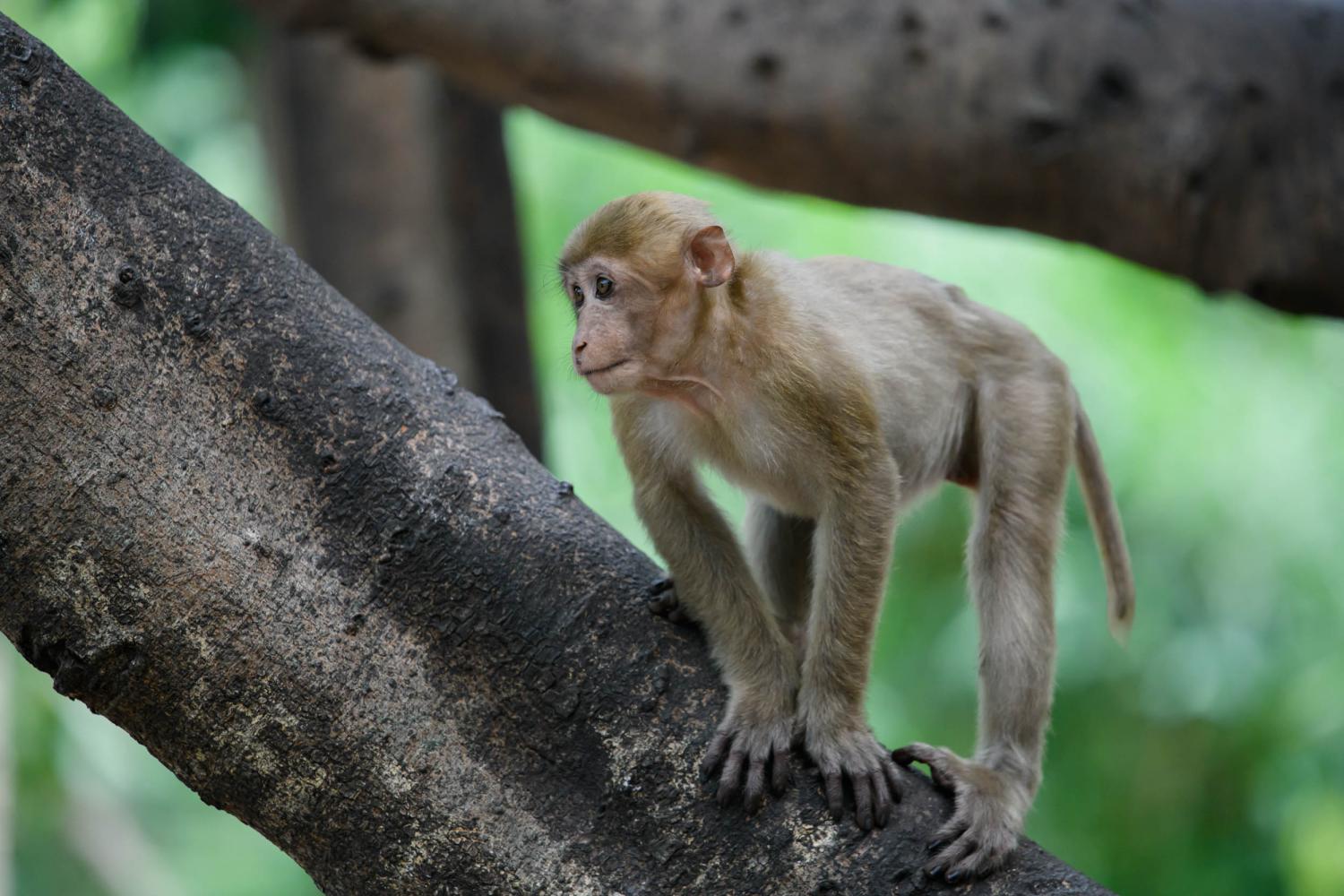Species of Thailand
Assam macaque
Macaca assamensis
John McClelland, 1840
In Thai: ลิงอ้ายเงี๊ยะ
The Assam macaque (Macaca assamensis) or Assamese macaque is a macaque of the Old World monkey family native to South and Southeast Asia. Since 2008, it has been listed as Near Threatened on the IUCN Red List, as it is experiencing significant declines due to poaching, habitat degradation, and fragmentation.
Characteristics
The Assam macaque has a yellowish-grey to dark brown pelage. The facial skin is dark brownish to purplish. The head has a dark fringe of hair on the cheeks directed backwards to the ears. The hair on the crown is parted in the middle. The shoulders, head and arms tend to be paler than the hindquarters, which are greyish. The tail is well-haired and short. Head-to-body-length measures 51 to 73.5 cm, and the tail is 15 to 30 cm long. Adult weight is 5 to 10 kg.
Distribution and habitat
In Nepal, the Assam macaque occurs east of the Kali Gandaki river at elevations of 200 - 1800 m. In northeastern India, it lives in tropical and subtropical semievergreen forests, dry deciduous and montane forests up to elevations of 4000 m. In Laos and Vietnam, it prefers elevations above 500 m. It usually inhabits hilly areas above 1000 m, but in the wetter east it also occurs in the lowlands below this elevation. In limestone karst forests, it also occurs at lower elevations.
Ecology and behaviour
Assam macaques are diurnal, and at times both arboreal and terrestrial. They are omnivorous and feed on fruits, leaves, invertebrates and cereals.
In Namdapha National Park, Arunachal Pradesh, 15 groups were recorded in 2002 comprising 209 individuals. The population had a group density of 1.11 individuals per 1 km2, and an average group size of 13.93 individuals.
During a survey in Nepal's Langtang National Park in 2007, a total of 213 Assamese macaques were encountered in 9 groups in the study area of 113 km2. Troop sizes varied between 13 and 35 individuals, with a mean troop size of 23.66 individuals, and comprised 31% adult females, 16% adult males, and their young of various ages. They preferred maize kernals, followed by potato tubers, but also raided fields with wheat, buckwheat, and millet.
Threats
The threats to this species' habitat include selective logging and various forms of anthropogenic development and activities, alien invasives, hunting and trapping for sport, medicine, food, and the pet trade. Additionally, hybridization with adjacent species poses a threat to some populations.
Conservation
Macaca assamensis is listed in CITES Appendix II. It is legally protected in all countries of occurrence. For the populations in India, the species is listed under Schedule II, part I of the Indian Wildlife Act.
This article uses material from Wikipedia released under the Creative Commons Attribution-Share-Alike Licence 3.0. Eventual photos shown in this page may or may not be from Wikipedia, please see the license details for photos in photo by-lines.
Scientific classification
- Kingdom
- Animalia
- Phylum
- Chordata
- Class
- Mammalia
- Order
- Primates
- Family
- Cercopithecidae
- Genus
- Macaca
- Species
- Macaca assamensis
Common names
- German:
- Assam-Makak
- Bergrhesus
- English:
- Assamese macaque
- Eastern Assamese macaque
- Western Assamese macaque
- Assam macaque
- Spanish: Macaca del Himalaya
- French: Macaque D' Assam
- Italian: Macaco dell'Assam
- Dutch:
- Assammakaak
- Bergresusaap
- Swedish: Assammakak
- Thai: ลิงอ้ายเงี๊ยะ
Subspecies
Macaca assamensis assamensis, John M'Clelland, 1840
Common name: Eastern Assamese macaque
Range: Bhutan, Arunachal Pradesh, Assam, Manipur, Meghalaya, Mizoram, Nagaland, Sikkim, and Tripura in northeastern India, into northern Myanmar, southeast through the Myanmar-Thailand border ranges as far as Chongkrong, to the upper Mekong in Tibet, into the provinces of Guangxi, Guizhou, Tibet and Yunnan in southwestern China, in Thateng in northern Laos, and Hoi Xuan in northern Vietnam
Macaca assamensis pelops, Brian Houghton Hodgson, 1840
Common name: Western Assamese macaque
Range: Central Nepal through Uttar Pradesh, Sikkim, Assam and northernmost West Bengal in northern India, into central Bhutan and the Sundarbans in Bangladesh
Synonyms
- Macaca coolidgei, Wilfred Hudson Osgood (1932)
- Macaca rhesosimilis, Philip Lutley Sclater (1872)
- Macaca problematicus, John Edward Gray (1870)
- Macaca sikimensis, Brian Houghton Hodgson (1867)
- Macaca macclellandii, John Edward Gray (1846)
Conservation status

Near Threatened (IUCN3.1)
Photos
Please help us review our species pages if wrong photos are used or any other details in the page is wrong. We can be reached via our contact us page.
Range Map

- Doi Inthanon National Park
- Doi Pha Hom Pok National Park
- Doi Phu Kha National Park
- Doi Suthep - Pui National Park
- Erawan National Park
- Huai Kha Khaeng Wildlife Sanctuary
- Mae Sai District, Chiang Rai
- Nam Nao National Park
- Phu Khiao Wildlife Sanctuary
- Phu Kradueng National Park
- Tat Mok National Park
- Tham Pha Tha Phon Non-Hunting Area






